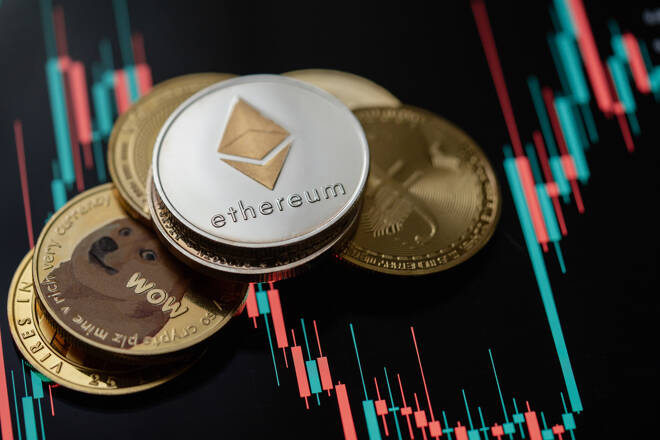Advertisement
Advertisement
ETH to Retarget $2,000 Based on Post-Shapella Upgrade Estimates
By:
ETH faces another major event, with the Shapella upgrade in focus today. Unstaking numbers will have a material influence on ETH price action.
Key Insights:
- On Tuesday, ETH fell by 0.99% to end the day at $1,892.
- A modest increase in ETH staking ahead of the Shapella Upgrade left ETH on the back foot.
- However, the technical indicators remain bullish, signaling a return to $2,000.
Ethereum (ETH) fell by 0.99% on Tuesday. Partially reversing a 2.74% gain from Monday, ETH ended the day at $1,892. Despite the bearish session, ETH avoided sub-$1,850 for the first time in five sessions.
A bullish start to the day saw ETH rise to an early high of $1,939. Coming up against the First Major Resistance Level (R1) at $1,938, ETH fell to a late low of $1,883. However, steering clear of the First Major Support Level (S1) at $1,866, ETH retested resistance at $1,900 before easing back.
Staking Inflows Remain Subdued Ahead of the Shapella Upgrade
ETH staking inflows climbed higher on Tuesday but remained below recent intra-week levels. According to CryptoQuant, staking inflows increased from 9,024 ETH on Monday to 11,456 on Tuesday. While rising for a third consecutive day, inflows were well below the levels from the previous week.
We expect investors to shift focus to total value staked figures later today, with the Shapella upgrade allowing the unstaking of ETH from approximately 2227 UCT.
Sentiment toward the Shapella upgrade remains bullish, with less than 12 hours remaining.
Glassnode estimates that only 100,000 ($190 million) of the total accumulated rewards will be withdrawn and sold. Additionally, the platform expects 70,000 ETH ($133 million) to be unstaked. The combined total of 170,000 is minor relative to the 18.1 million staked ETH on the Beacon Chain.
Based on these figures, the Shapella Upgrade and resulting unstaking volumes should have a limited ETH price impact.
The Day Ahead
Total value staked figures will draw interest before and after the Shapella upgrade. Movements in line with Glassnode estimates should provide ETH price support.
However, updates from the ongoing SEC v Ripple case will also move the dial. A Ripple win in the SEC v Ripple case could see the SEC lose government support to regulate the digital asset space. Binance and Coinbase (COIN)-related news will also influence.
US economic indicators and Fed monetary policy will need consideration this afternoon. A hotter-than-expected US CPI Report would support a hawkish Fed interest rate hike in May, which could reignite fears of a US recession and global liquidity crunch.
We also expect plenty of chatter from the IMF/World Bank Spring Meetings, with anti-crypto rhetoric likely to impact ETH and the broader crypto market.
Ethereum Price Action
At the time of writing, ETH was down 1.29% to $1,867. A mixed start to the day saw ETH rise to an early high of $1,899 before falling to a low of $1,856. ETH fell through the First Major Support Level (S1) at $1,870.
ETH Technical Indicators
ETH needs to move through S1 and the $1,905 pivot to target the First Major Resistance Level (R1) at $1,926 and the Tuesday high of $1,939. A return to $1,900 would signal a breakout session. However, the crypto news wires should be crypto-friendly to support a breakout.
In the event of an extended rally, the bulls would likely test the Second Major Resistance Level (R2) at $1,961 and resistance at $2,000. The Third Major Resistance Level (R3) sits at $2,017.
Failure to move through S1 and the pivot would leave the Second Major Support Level (S2) at $1,849 in play. However, barring an event-fueled crypto market sell-off, ETH should avoid sub-$1,800 and the Third Major Support Level (S3) at $1,793.
Looking at the EMAs and the 4-hourly candlestick chart (below), it was a mixed signal. Ethereum sat above the 50-day EMA, currently at $1,866. The 50-day EMA flattened on the 100-day EMA, while the 100-day EMA widened from the 200-day EMA, delivering bullish signals.
A hold above the 50-day EMA ($1,866) would support a move through S1 ($1,870) to target R1 ($1,926) and the Tuesday high of $1,939. However, a fall through the 50-day EMA ($1,866) would bring S2 ($1,849) and the 100-day EMA ($1,835) into view. A fall through the 50-day EMA would send a bearish signal.
About the Author
Bob Masonauthor
With over 28 years of experience in the financial industry, Bob has worked with various global rating agencies and multinational banks. Currently he is covering currencies, commodities, alternative asset classes and global equities, focusing mostly on European and Asian markets.
Advertisement
